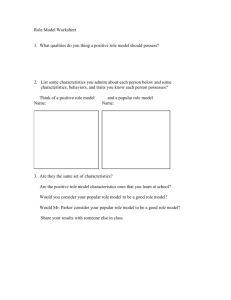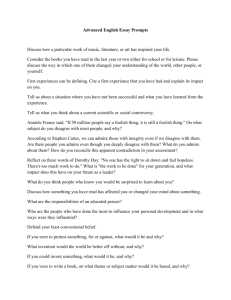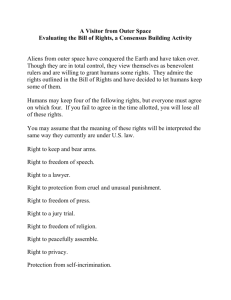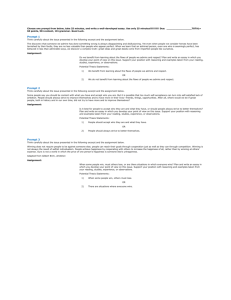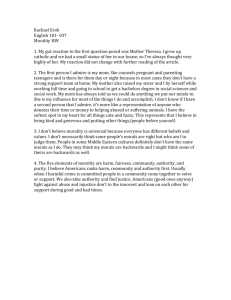PART 1 MODULE 3 VENN DIAGRAMS AND SURVEY PROBLEMS
advertisement
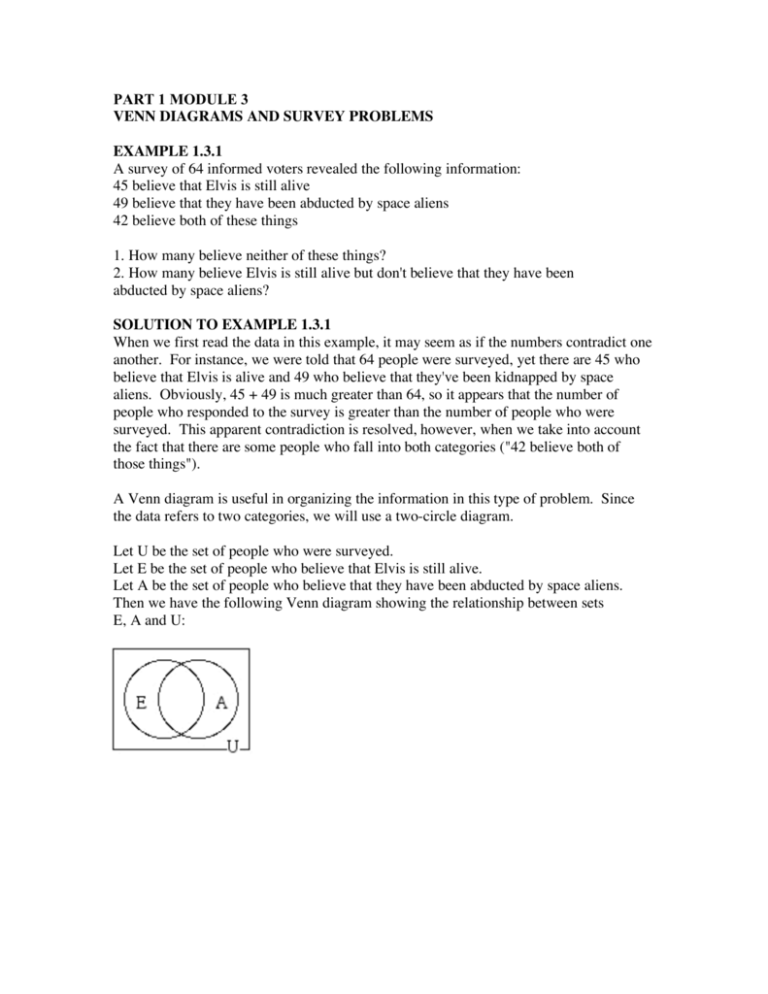
PART 1 MODULE 3 VENN DIAGRAMS AND SURVEY PROBLEMS EXAMPLE 1.3.1 A survey of 64 informed voters revealed the following information: 45 believe that Elvis is still alive 49 believe that they have been abducted by space aliens 42 believe both of these things 1. How many believe neither of these things? 2. How many believe Elvis is still alive but don't believe that they have been abducted by space aliens? SOLUTION TO EXAMPLE 1.3.1 When we first read the data in this example, it may seem as if the numbers contradict one another. For instance, we were told that 64 people were surveyed, yet there are 45 who believe that Elvis is alive and 49 who believe that they've been kidnapped by space aliens. Obviously, 45 + 49 is much greater than 64, so it appears that the number of people who responded to the survey is greater than the number of people who were surveyed. This apparent contradiction is resolved, however, when we take into account the fact that there are some people who fall into both categories ("42 believe both of those things"). A Venn diagram is useful in organizing the information in this type of problem. Since the data refers to two categories, we will use a two-circle diagram. Let U be the set of people who were surveyed. Let E be the set of people who believe that Elvis is still alive. Let A be the set of people who believe that they have been abducted by space aliens. Then we have the following Venn diagram showing the relationship between sets E, A and U: We are told that there are 42 people who "believe both of these things." This means that in the region of the diagram where set E intersects set A, we have 42 people: We are also told that "45 believe that Elvis is still alive." This means that set E must contain a total of 45 people. We have already placed 42 people in one region of set E, so we must place 3 people in the other region of set E: We are also told that "49 believe that they have been abducted by space aliens." This means that set A must contain 49 people. Since 42 of them have already been place in one part of circle A, we must have 7 people in the other part of circle A: Finally, we are told that 64 people were surveyed. This means that there must be a total of 64 people in this universe. So far, we have placed 52 people in three regions of the universe. Therefore, there must be 12 people in the region that is outside of the two circles: Now that we have organized the given information so that there is one number in each of the four regions of the Venn diagram, we can use the diagram to answer the questions. 1. How many believe neither of these things? If a person believes neither of these things, then the person isn't in set E and isn't in set A. The diagram shows us that 12 people satisfy this description. 2. How many believe Elvis is still alive but don't believe that they have been abducted by space aliens? A person who fits this description is simultaneously inside of circle E yet outside of circle A. The diagram shows us that there are 3 of these people. EXAMPLE 1.3.2 A survey of used car salesmen revealed the following information: 24 wear white patent-leather shoes 28 wear plaid trousers 20 wear both of these things 2 wear neither of these things 1. How many were surveyed? 2. How many wear plaid trousers but don't wear white patent-leather shoes? EXAMPLE 1.3.3 A survey of faculty and graduate students at the University of Florida's film school revealed the following information: 51 admire Moe 49 admire Larry 60 admire Curly 34 admire Moe and Larry 32 admire Larry and Curly 36 admire Moe and Curly 24 admire all three of the Stooges 1 admires none of the Three Stooges a) How many people were surveyed? b) How many admire Curly, but not Larry nor Moe? c) How many admire Larry or Curly? d) How many admire exactly one of the Stooges? e) How many admire exactly two of the Stooges? SOLUTION Step 1: We will organize the information in the following Venn diagram, where "M," "L," and "C" represent the sets of those who admire Moe, Larry and Curly, respectively: Step 2: "24 admire all three of the Stooges:" Step 3: Step 4: "1 admires none of the Three Stooges:" "36 admire Moe and Curly:" Step 5: Step 6: "32 admire Larry and Curly: "34 admire Moe and Larry:" Step 7: Step 8: "60 admire Curly:" "51 admire Moe" Step 9: "49 admire Larry" Now that we have one number in each of the diagram's eight regions, we use the numbers to answer the given questions. a) How many people were surveyed? We add all eight numbers. 5 + 10 + 7 + 12 + 24 + 8 + 16 + 1 = 83 b) How many admire Curly, but not Larry nor Moe? These are the ones who are simultaneously inside of circle C yet outside of the other two circles. The diagram shows that the answer is "16." c) How many admire Larry or Curly? Unless we specify otherwise, we always use the word "or" in the inclusive sense, so that this means "admire Larry, or admire Curly, or admire both." Those who satisfy this compound condition are underlined in the diagram below. 10 + 7 + 24 + 8 + 12 + 16 = 77 d) How many admire exactly one of the Stooges? There are three possibilities: admires Moe but not Curly and not Larry, admires Larry but not Curly and not More, or admires Curly but not Moe and not Larry. Those who satisfy this compound condition are underlined in the diagram below. 5 + 7 + 16 = 28 e) How many admire exactly two of the Stooges? Again, there are three possibilities: admires Moe and Larry but not Curly, admires Moe and Curly but not Larry, or admires Larry and Curly but not Moe. Those who satisfy this compound condition are in the regions underlined below: 12 + 10 + 8 = 30 EXAMPLE 1.3.4 A survey of 39 guests on the Jerry Slinger show revealed the following: 10 punch 18 curse 19 make obscene gestures 3 punch and curse and gesture 12 curse but don't punch and don't gesture 4 curse and gesture 4 punch and gesture but don't curse How many... 1. ...engage in none of the three activities? 2. ...punch and curse? 3. ...curse or gesture? 4. ...engage in exactly one of these activities? EXAMPLE 1.3.5 A group incoming first-year students at Major University were surveyed in order to determine the factors that influenced their decisions to choose to attend Major U. The survey revealed the following information. 55 said "great football team" (F) 51 said "excellent party reputation" (P) 61 said "it was the only place that would accept me" (O) 9 said "great football team" but didn't say "excellent party reputation" and didn't say "it was the only place that would accept me" 26 said "it was the only place that would accept me" and "great football team" and "excellent party reputation" 31 said "excellent party reputation" and "great football team" 8 said only "excellent party reputation" 4 said none of the above reasons A - C: How many said A. "it was the only place that would accept me" and "excellent party reputation"? B. "great football team" or "it was the only place that would accept me"? C. "great football team" but not "excellent party reputation"? D. How many were surveyed? WORLD WIDE WEB NOTE For unlimited practice involving Venn diagrams and survey situations visit the companion web site and try The SURVEYOR. HOMEWORK EXERCISES 1. A number of deer were surveyed about activities that they enjoy. The results are summarized in the Venn diagram below. How many… A. …enjoy running or staring into headlights? B. …enjoy nibbling and running? C. …enjoy exactly one of these activities? D. …enjoy staring into headlights but not running? E. …enjoy nibbling? 2. A survey of 50 Yugo drivers revealed the following: three drive Yugos because of the comfort; four drive Yugos because of the reliability; one drives a Yugo for both of these reasons. A. How many drive Yugos for neither of these reasons? B. How many drive Yugos because of the comfort but not because of the reliability? 3. 110 dogs were asked “Why do you like to eat garbage?” 89 said “It tastes great!” 87 said “It’s more filling!” 68 said “It tastes great!” and “It’s more filling!” A. How many said “It’s more filling!” but didn’t say “It tastes great!”? B. How many said neither of those things? 4. A number of whales were asked about things that they dislike. 19 dislike giant squids 6 dislike giant squids and pollution and Captain Ahab 24 dislike Captain Ahab 4 dislike pollution but don’t s dislike giant squids and don’t dislike Captain Ahab 11 dislike Captain Ahab and giant squids 3 dislike pollution and Captain Ahab but don’t dislike giant squids 20 dislike pollution 5 have no dislikes A. How many whales were surveyed? B. How many dislike at least one of those three things? C. How many dislike Captain Ahab but don’t dislike giant squids? D. How many dislike giant squids or pollution? 5. A number of classicists were asked to identify their favorite epic poets. The results are summarized below. 62 appreciate Homer 40 appreciate Virgil 5 appreciate Gomer 2 appreciate Homer and Virgil and Gomer 3 appreciate Virgil and Gomer 20 appreciate Homer and Virgil 42 appreciate Homer and neither of the other two 12 appreciate none of these three epic poets A. How many were surveyed? B. How many don’t appreciate Gomer? C. How many appreciate Homer or Gomer? D. How many appreciate exactly one of the three epic poets? 6. Fifty elephants were asked about things that they like. 8 like tigers 6 like ivory carvings 9 like mice 1 likes all three of these things 4 like tigers and ivory carvings 5 like tigers and mice 3 like mice and ivory carvings A. How many like none of these things? B. How like ivory carvings but don’t like tigers? C. How many like fewer than two of these things? D. How many like mice or ivory carvings? 7. The members of the Gainesville Film Critics Society were surveyed regarding their cinematic heroes. 38 admire Moe 36 admire Larry 21 admire Curly 23 admire Moe and admire Larry 5 admire Larry and admire Curly 7 admire Moe and admire Curly 3 admire Moe and admire Larry and admire Curly 16 don't admire Moe and don't admire Larry and don't admire Curly A. How many were surveyed? B. How many admire at least one of the Stooges? C. How many admire Moe or Larry? 8. A number of Yugo owners were surveyed regarding their favorite activities. 57 enjoy walking 65 enjoy waiting for tow trucks 60 enjoy hitchhiking 20 enjoy waiting for tow trucks and enjoy hitchhiking and enjoy walking 22 enjoy hitchhiking and enjoy walking 12 don't enjoy waiting for tow trucks and don't enjoy hitchhiking and don't enjoy walking 23 enjoy walking but don't enjoy hitchhiking and don't enjoy waiting for tow trucks 38 enjoy waiting for tow trucks and enjoy hitchhiking A. How many were surveyed? B. How many enjoy at least two of these activities? 9. 100 Neanderthals were surveyed regarding their favorite possessions. 13 own a bone and own a stick 32 own a stick 3 own a rock and own a bone and own a stick 30 own a rock 14 own a rock and own a bone 31 own a bone 12 own a rock and own a stick How many own none of these things? ANSWERS TO LINKED EXAMPLES EXAMPLE 1.3.2 EXAMPLE 1.3.4 EXAMPLE 1.3.5 1. 34 2. 8 1. 5 1. 5 2. 5 2. 63 3. 33 3. 18 ANSWERS TO HOMEWORK EXERCISES 1. 2. 3. 4. 5. 6. 7. 8. 9. A. 88 A. 44 A. 19 A. 41 A. 96 A. 38 A. 79 A. 122 43 B. 29 B. 2 B. 2 B. 36 B. 91 B. 2 B. 63 B. 52 C. 35 D. 43 C. 13 C. 65 C. 40 C. 51 D. 26 D. 63 D. 12 E. 54 4. 24

